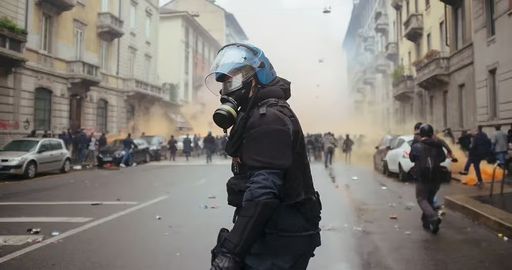The Banlieues, otherwise known as the French suburbs, began in the 1950s due to a severe housing crisis when high-rise apartment complexes came up in large cities. These banlieue have always been home to residents who could not afford housing in the cities themselves. Today, it's estimated that about five million people live in the Banlieues. In addition to their poor connectivity to the city centers and bleak living conditions, the unemployment rate in these suburbs is twice the national average. The educational level is also much lower than average. The Banlieues quickly became places of social downfall, populated by a high proportion of Arab and African immigrants – today, social housing is almost exclusively inhabited by immigrant families. Unemployment, crime, radicalization, and rundown streets have led to these areas being stigmatized, contributing to the formation of parallel societies. Youth unemployment is now over 50 percent in some areas. Young people who don’t venture into criminality often seek solace and refuge in the religion of their immigrant father's. In the mosques or churches, these young people don't face discrimination because of their origin from the Banlieues – unlike in job and housing search. The young people in these suburbs feel abandoned by politics – they commonly face racism, social exclusion, police violence, and a lack of prospects. All these factors create a ticking time bomb that could explode at any moment.
The Banlieue - The Anger in France's Outskirts
The French suburbs, once constructed to ease the housing shortage, have become social hotspots today. High unemployment, lack of prospects, and increasing readiness for violence frequently lead to serious unrest. How much longer can France handle this pressure?

The Youth Uprisings in Autumn 2005
Everything started when two teenagers from the suburb of Clichy felt pursued by the police on their way home. Because they didn't have their documents with them, they decided to avoid the imminent police check and hid in a power substation - tragically, they both died from electric shock there. The news of the boys' death spread like wildfire; the police quickly became the enemy of the socially disadvantaged youth. Acts of violence broke out the same evening - cars and shops were set on fire, and the police were confronted violently. When a tear gas bomb from the police exploded in the mosque of Clichy two days later, riots spread throughout all the suburbs of France. Schools and kindergartens were destroyed, cars and buses were burning, police officers and firefighters were attacked - the anger was directed against the state, which these people felt had abandoned them in the banlieue. The riots were so intense that on November 7, 2005, the French government declared a state of emergency and imposed curfews. It took three weeks to normalize the situation - ten thousand cars were torched, four people died, and there were hundreds of injuries and five hundred public buildings damaged. President Jacques Chirac at the time proposed a "Marshall Plan" for the banlieue as a consequence, investing billions in efforts to renovate problem areas and provide educational, social, and cultural resources, as well as fight crime - but the positive impact was limited. Since 2005, there have been numerous further riots in France. In 2023, the situation escalated alarmingly once again.
The Death of 17-Year-Old Nahels by a Police Shot in June 2023
The young man of Algerian descent was shot by a policeman on June 27 in Nanterre, a western suburb of Paris, when he tried to evade a traffic stop. The video of the teenager's killing, recorded by a witness, was almost simultaneously spread on social media. This led to violent riots, with protestors erecting roadblocks and clashing significantly with the police. In the following days, the violence against the police spread to several French cities - leading to violence, fires, looting, and attacks with fireworks. Major events were canceled. Right-wing militants marched as a "vigilante force" into the suburbs, activists of the banned organization "Alvarium" attacked protestors with batons and stabbing weapons. The escalation of violence lasted until July 3 - again, thousands of vehicles and buildings were set on fire, 700 officers injured, and a thousand shops destroyed and looted by acts of vandalism. The damage amounted to 650 million Euros. The average age of those arrested was 17, many of whom were deeply rooted in the criminal milieu and believed that only violence would change their precarious circumstances.
What Does the Future Hold for France?
Mass riots in France are not unusual, however, the frequency and intensity have been steadily increasing in recent years. It only takes the slightest trigger, and thousands, often violent, take to the streets and set entire neighborhoods on fire. The divide between the traditional society and the migrants living in the country is growing due to the increasing political contrasts in Western democracies. On one hand, there is the left with its open immigration policy, and on the other, the right with its indispensable emphasis on tradition and the nation-state. The polarization of the population in France continues to increase. The fact that the strongest party in the 2024 elections, the National Rally, is winning more and more votes is an expression of failed integration policy. Despite efforts and investments, the situation in France's suburbs continues to deteriorate - Macron has admitted on several occasions that integration has not been successful. The lack of prospects among the inhabitants of the Banlieues is becoming increasingly visible - the slightest incident can trigger the onset of a new conflict on the streets. Next time, due to the division of the French population, it might not stop at a mere conflict - even Macron warned of a potential escalation and the possibility of a civil war before the last elections in June 2024.




